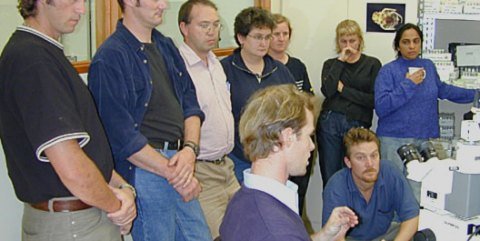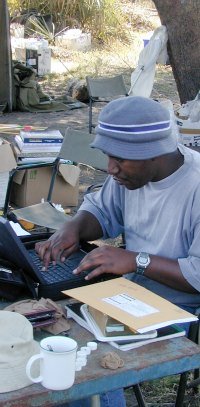Home | About CCW | Contact Us | Climate change Meaning | Causes | Solutions | Emissions | Carbon trading
Teaching climate change
Teaching climate change is both easy and hard.
The basic principles are simple enough. The greater the energy received and retained in the atmosphere and oceans the warmer and more dynamic those fluids become with consequences for the land they surround.
Less energy received and/or retained and the skin of the earth cools and the atmosphere and oceans slow down.
The physics and chemistry of energy absorption and transfer, how it all works, is more complex in detail but these basics are easy to grasp.
Teaching climate change basics for the global carbon cycle are also simple enough to explain.
On land, plants take up CO2, convert it to biomass that eventually dies and is decomposed releasing CO2 back into the atmosphere.

In the oceans there is a similar route through phytoplankton, only the decomposition is far slower plus there is the direct ocean-atmosphere exchange of CO2.
Most high school students understand so far.
Again the technical specifics can be absorbing and take some expertise to fully grasp, but the heat exchange and carbon dynamics form the foundation of climate.
Combine the subjects of atmospheric physics, oceanography and ecosystem ecology and you have the building blocks to understand teaching climate change.
Teaching about change
Now we get to a concept that is harder to teach.
The idea that already dynamic processes are in sufficient flux to result in a detectable change to the climate.
That these changes are on time scales longer than we can normally imagine.
And that the fluxes are due to external drivers.

Change is hard to measure because it has both a magnitude and a rate. Information on both is needed or must be defined before change can be measured.
Only putting magnitudes and rates is equivalent to putting artificial boundaries on a continuous process.
And that is a tricky concept to explain.
Teaching about why
Harder still is the why question.
Teaching requires that we understand that we bound something, then establish that it has shifted from those bounds in order to quantify change.
Only change is relative. It is only important when compared to something that we value.
Climate change has always been part of the earth's pattern. A significant, perhaps the most significant, driver of evolution. Without it we would not be here.
But because change now affects our production systems, water supplies and the success of our economies, it obtains critical importance.
This logic is far harder to teach and is not in the standard textbooks on the physics, oceanography and ecology.
Equally hard is the politics.
It is difficult to understand how the fear of economic risk brought about by the likely climate change effects on production and from emission reduction measures, affects decision makers and public servants.
- Why did the US and China do a backroom deal in Copenhagen?
- Why has the UNFCCC process been so slow?
- Why within countries is there political conflict on the climate change issue?
In the end the challenge for teaching climate change is that climate change is not really about the science.
It is about human responses to a world that is not as big or as bountiful as we once thought it was.

Back to top of Teaching climate change | Back to What is climate change? | Back to Climate-change-wisdom home page

Recent Articles
-
Reducing emissions while looking for solutions...
Nov 01, 15 04:46 PM
I've seen a lot of post's online for ideas on reducing emissions. The one suggestion I have not seen, is the most obvious. There should be a government -
Climate change evidence
Mar 24, 15 06:22 AM
Real climate change evidence has to demonstrate a change in climate. An extra sunny day or a severe storm or a flood is not enough. -
The climate change effect
Feb 19, 15 03:08 AM
What will be the climate change effect? There isn't one, there are many. Perhaps too many for us to understand.

New! Comments
Have your say about what you just read! Leave me a comment in the box below.